|
|
Review:
Godzilla vs. Space Godzilla
Godzilla vs. Destroyah
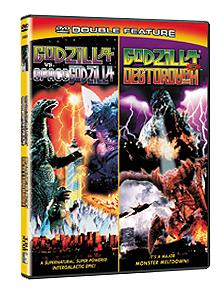
Godzilla vs. Space Godzilla/Godzilla vs. Destroyah
Columbia Tri-Star Home Video
Color, Widescreen, 1.85:1
Enhanced for 16 x 9 televisions
Dolby Digital Stereo 2.0
Subtitles: English, French, Spanish
Region 1
Not rated
Starring Megumi Odaka, Kenji Sahara, Jun Hashizume, Zenkichi Yoneyama, Akira Emoto,
Yosuke Saito, Tawako Yoshikawa (Godzilla vs. Space Godzilla);
Momoko Kochi, Megumi Odaka, Yasufumi Hayashi, Yoko Ishino, Tatsumi Takuro, Masahiro Takashima
(Godzilla vs. Destroyah)
Directed by Kenshou Yamashita
(Godzilla vs. Space Godzilla); Takao Okawara (Godzilla vs. Destroyah)
Reviewed by Gary Teetzel
After the failure of Godzilla 1985 at the U.S. box office, the world's most famous
radioactive lizard disappeared from American movie screens. Although Japan's Toho Studios
continued to produce sequels that were quite popular in Godzilla's homeland, this new
series of films, known as the Heisei1
series to the Godzilla cognoscenti, never acquired
a U.S. theatrical distributor. One film, 1989's Godzilla vs. Biollante (a.k.a.
Gojira vs. Biorante) turned up on VHS and laserdisc in the early 90's, but, by and
large, American fans wanting to catch the latest adventures of the supersized saurian
had to purchase either blurry bootleg tapes sold at science fiction conventions or pricey
Japanese laserdiscs. The situation finally changed when, as part of its deal with Toho
to produce the 1998 American Godzilla, Tri-Star picked up the rights to the five
Heisei Godzilla films made after Biollante.
In 1998 two of the Heisei films appeared on DVD for the first time when Columbia Tri-Star
Home Video released a double feature disc of 1991's Godzilla vs. King Ghidorah
(Gojira vs. Kingugidora) and 1992's Godzilla and Mothra: The Battle For the Earth
(Gojira vs. Mosura). The disc disappointed many kaiju eiga
2 fans, presenting the films in
dubbed, mono, pan-and-scan transfers. Columbia Tri-Star's new Godzilla double
feature represents an improvement over the earlier effort, but falls short of its full
potential. Bypassing the entertaining 1993 entry Godzilla vs. Mecha-Godzilla
(Gojira vs. Mekagojira), the disc pairs 1994's Godzilla vs. Space Godzilla
(Gojira vs. Supeesu Gojira) and 1995's Godzilla vs. Destroyah (Gojira vs.
Desutoroia).
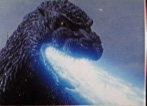
In Godzilla vs. Space Godzilla, Godzilla cells carried into outer space merge with
a crystalline life form and are then mutated by a black hole, forming a deadly new monster
dubbed Space Godzilla. The creature arrives on Earth bent upon wreaking worldwide devastation.
Aware that only Godzilla possesses the power to destroy it, Space Godzilla confronts its
progenitor on a South Pacific island. Unable to defeat Godzilla in battle, Space Godzilla
entraps the monster's son in a prison of crystals, then heads to the Japanese city of
Fukuoka. There, it erects vast crystal spires that it uses to gather energy. Faced
with this new threat, G-Force, Japan's counter-Godzilla agency, decides to use its new
giant robot, Mogera, against the monster. When Godzilla arrives on the scene, the pilots
operating Mogera find that they must join forces with their old adversary to defeat the
alien creature that threatens all of humanity.
Space Godzilla is widely regarded as the weakest of the Heisei series, and it isn't
hard to see why. From story to special effects to music, the film is either derivative
of earlier entries or simply uninspired. Things seem to have gone wrong from the very
start, with the selection of Godzilla's foe. Although the notion of a monster spawned
by the blending of Godzilla with an alien crystalline lifeform may conjure up bizarre
and exotic visions in one's imagination, the filmmakers deliver instead a dull creation
that merely looks like a more evil Godzilla with big crystal cones protruding from its
shoulders. At times Space Godzilla demonstrates some unique powers -- it can levitate
objects and can generate a protective forcefield around itself -- but these are
underutilized. (If Space Godzilla can protect itself with a forcefield, why doesn't
it do so all the time?)
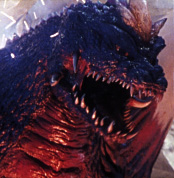
The film's "supporting monsters" fare little better. Mogera, a new version of the
mechanical menace featured in 1957's
The Mysterians
(a.k.a. Chikyu Boeigun), is
well done technically, (see image bottom of page) but its scenes are essentially a rehash of similar--and better--sequences
of the titular robot in Mecha-Godzilla, made just one year before. Kids probably
won't care, though, and will most likely enjoy Mogera's many weapons and gadgets,
including its ability to separate into two vehicles, one that flies and one that
drills underground. Worse by far is Godzilla's offspring, Little Godzilla (see image below) When
introduced in Mecha-Godzilla, the tyke was about the size of a man and
resembled its father. In Space Godzilla, it has grown considerably, but appears
to have metamorphosed into something from the "Hello Kitty" cartoons. Little Godzilla
is designed to look as adorable as possible, with big round eyes, chubby little cheeks
and a happy smile on its face. He's the most nauseatingly cute creature to appear in
a science fiction film since George Lucas unleashed Ewoks upon an unsuspecting world,
and his scenes are a painful reminder of the campy Godzilla adventures of the 1970's.
Hiroshi Kashiwabara's screenplay suffers from an excess number of underdeveloped characters
and plot threads, a problem common in the Heisei films. Much of the first half of the
film is devoted to the implementation of "Project T", a plan by G-Force to insert a device
in Godzilla's neck, close to the spine and brain, that will allow them to control
the monster through electronically amplified telepathy. After Space Godzilla arrives,
though, Project T is largely forgotten. Psychic Miki Saegusa (Megumi Odaka) is sympathetic
to Godzilla and raises moral objections to the idea of manipulating the monster; why
not have her use Project T technology to help Godzilla during the climactic battle? A
hint of romance develops between Miki and G-Force Lieutenant Koji Shinjo (Jun Hashizume),
but this too is dropped once the monster mayhem starts. The strangest subplot has a
G-Force scientist (Yosuke Saito) turn rogue after the initial failure of Project T.
He partners with the Japanese Mafia and kidnaps Miki, explaining to the girl that they
plan to control Godzilla to gain power. (Godzilla as mob enforcer???) Miki is rescued
very quickly, causing one to wonder why the filmmakers bothered to include the contrived
kidnapping/mad scientist subplot in the first place. As if all of this weren't enough,
there's also a G-Force squad member (Akira Emoto) seeking revenge against Godzilla
for the death of a close friend.
The special effects in Space Godzilla are below average for the series. A space
battle between Mogera and Space Godzilla, fought amongst asteroids that resemble potatoes,
is simply embarrassing. Since the battle in Fukuoka is chiefly fought amid Space Godzilla's
crystal spires and not buildings, any sense of the monsters' scale is greatly diminished.
Some shots of the monsters composited against real backgrounds of the city are capably
handled, but are no better then similar sequences in other Godzilla films. Further
diluting the impact of the visuals is the weak musical score by Takayuki Hattori, filling
in for the series' regular composer, Akira Ifukube. Much of the score sounds like a
pale imitation of John Williams or Jerry Goldsmith, and it is often mercifully buried
in the sound mix.
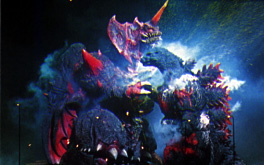
If Godzilla vs. Space Godzilla shows the Godzilla creative team suffering from burnout,
Godzilla vs. Destroyah shows them working hard to provide the series with a grand
finale. The film opens with Godzilla appearing in Hong Kong with his chest glowing orange
and steam rising from his body. Scientists determine that the nuclear fission that powers
the monster is escalating out of control. When Godzilla�s body temperature reaches 1200
degrees, he will suffer a meltdown like a nuclear reactor, and the resulting radiation
will turn Japan into an uninhabitable wasteland. While G-Force tries to figure out a
way to avert disaster, a new race of two-meter tall, crab-like creatures appear in an
underground tunnel. They are prehistoric crustaceans mutated by the Oxygen Destroyer,
the deadly weapon that killed the original Godzilla in 1954. Just as the military
prepares an offensive against them, the creatures merge into one giant monster named
Destroyer3. Realizing that Destroyer
might be powerful enough to kill Godzilla,
G-Force decides to bring the two monsters together, using Godzilla's now fully-grown son,
Godzilla Junior, as bait. Destroyer quickly kills the youngster and mutates into an
even larger form. With his out-of-control radioactive heart speeding him towards his
own inevitable demise, Godzilla arrives in Tokyo for one final battle, a showdown with
Destroyer to avenge his offspring's death . . .
Godzilla vs. Destroyah is a more satisfying film than Space Godzilla in almost
every respect, but is nonetheless seriously flawed. The story is more focused, and
Godzilla's impending death and the nuclear holocaust it will trigger creates a greater
sense of urgency. Unfortunately, Kazuki Omori's screenplay is so busy explaining
the monsters, keeping track of the monsters and coming up with methods of defeating
the monsters, that precious little time is devoted to developing the human characters. No
one in the cast is given a chance to do much besides deliver expository dialogue and
stand around and watch the monsters on monitors or through binoculars. (There's lots of
technobabble about "micro-oxygen," and endless discussion about what to do about Godzilla.)
Since the characters are mere devices for moving the story along, viewers soon lose
interest in them.
Omori tries to introduce a theme of ideological conflicts arising from generational or
cultural differences. For example, Dr. Kensaka Injuin (Tatsumi Takuro), a brash
young scientist working with micro-oxygen, is contrasted with the character of Dr.
Serizawa from the original film. Serizawa destroyed his notes and killed himself
to prevent the secrets he had unlocked from being misused; Injuin knows that his
work might lead to the development of a weapon of mass destruction, but disregards
the danger. (Reprising her role from the 1954 film, Momoko Kochi makes a cameo
appearance as Emiko Yamane, gravely warning of the horrors of Serizawa's Oxygen
Destroyer.) Similarly, psychic Miki Saegusa (Megumi Odaka), who has always felt
compassion for Godzilla and especially his son, is contrasted with American-trained
psychic Meru Ozawa (Sayaka Osawa) whose approach to her work with G-Force is more
dispassionate. Omori successfully weaved social commentary about post-war Japan's
transformation into an economic superpower into his screenplay for
Godzilla vs. King Ghidorah, but his efforts to invest Destroyer with some
thematic substance fall flat because there's no payoff to the conflicts he sets up. Dr.
Injuin may be reckless and short-sighted, but Destroyer is a consequence of Dr. Serizawa's
actions, not his. Perhaps the death of Godzilla Junior can be blamed (in part) on Meru
Ozawa's cold-heartedness (she and a reluctant Miki use their psychic powers to lead him
to Destroyer), but nobody mourns for him except for Godzilla and Miki. Omori also inserts
some anti-nuclear speeches into the film, but they carry no impact because by now such
speeches have become de rigueur for a Japanese monster movie, just part of the formula.
Godzilla vs. Destroyer has plenty of action, but the shortcomings of Omori's
screenplay leave the film rather hollow at its center.
The idea of pitting Godzilla against an embodiment of the weapon that killed his 1954
counterpart was an imaginative one, and Destroyer makes for a reasonably interesting opponent.
In its early stages, it takes the form of a many-legged crustacean, and its non-humanoid
shape does not immediately suggest a man in a rubber suit -- a nice change of pace.
Unfortunately, the effectiveness of the design is hurt every time the critter tries to walk.
It is painfully obvious that the creature is being rolled about by stagehands, and one is
never fooled into thinking that its flopping legs are supporting any of its weight. At the
climax Destroyer mutates into a more traditional bipedal man-in-a-suit monster, looking a
little like an armor-plated version of Space Godzilla. The final stage monster is meant to
impress us with a sense of power and massive size, but the suit instead looks bulky and awkward.
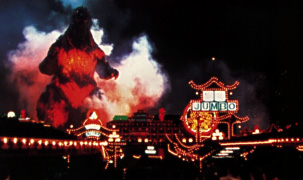
The appearance of Godzilla himself is altered in this film, with the creature's glowing
chest and dorsal fins a constant reminder that his body has become a ticking (nuclear) bomb.
In the film's prologue the bright, luminous orange of his body seems to visually echo the
lurid neon lights of downtown Hong Kong -- a clever touch that makes the sequence an eye-popping
treat. Godzilla Junior has, fortunately, grown out of his cartoon character stage from
Space Godzilla, and is depicted as a smaller version of Godzilla with less
prominent spines on his back.
The special effects are of variable quality. There are some well-done matte shots that
blend the monsters with real locations, and some respectable miniature work. Unfortunately,
the scope of the picture seems to have overtaxed Koichi Kawakita's effects crew, and there
are more than a few shots in which the miniatures look like toys in a child's playroom. This
is most evident during the scene in which the many small Destroyers merge into one, a
sequence that also suffers from weather continuity problems as rain starts and stops suddenly
between shots. Godzilla's much-publicized death is well-executed via a mix of physical
effects and CGI.
Veteran Godzilla composer Akira Ifukube came out of retirement at age 81 to score
Godzilla vs. Destroyer, and his return to the series is most welcome. Along with
his familiar themes for Godzilla and his son, Ifukube contributes a brisk march for G-Force's
new super-weapon, the Super-X 3, and a theme for Destroyer that evokes a genuine sense of
power and menace. During Godzilla's death, the music is allowed to take center stage:
the sound effects of G-Force's freezing weapons firing desperately at Godzilla are eliminated,
leaving only Ifukube's moving requiem. The score, especially the requiem, is a fine
capstone to an outstanding career.
Overall, Godzilla vs. Destroyer contains enough monster action to keep most kaiju
eiga fans happy. Children who like monsters and are not yet spoiled by sophisticated CGI
effects will probably love the film, although some may be upset by the monster death
scenes. It may not be Godzilla's greatest adventure, but it's a suitable conclusion to
the Heisei series.
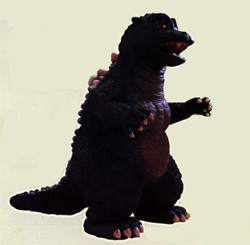
Columbia Tri-Star's double feature DVD offers a decent, if unspectacular, presentation
of the two films. Unlike their previous Godzilla double feature, the films on this
new disc are letterboxed at approximately 1.85:1, and both are 16 x 9 enhanced.
Space Godzilla gets off to a bad start with one of the most egregiously misframed
shots in recent memory: When the title for the film appears, the Japanese characters for
the word "Godzilla" are cropped in half by the upper matte, suggesting that the entire upper
third of the image has been eliminated. There are clear signs of bad framing throughout
the credit sequence: notice how the last letters in "Mogera" and "Star Falcon" are cropped
out when they appear (in English) on monitors. Fortunately, this sequence is the exception,
not the rule, and the framing for both features appears balanced and well-judged most of the
time. Aside from imperfect framing, the transfers are quite handsome. Details are sharp and
grain is negligible. The colors, from the subtle variations in skin tone to the vivid hues
of the monsters' assorted energy beams, are well reproduced.
The audio for both films is Dolby Digital Stereo, again an improvement over the previous disc,
but inferior to the original Japanese tracks, which were in Dolby Surround Sound4. Of the
two films, Destroyah has the livelier mix. Roars, explosions and Ifukube's score all have
a satisfyingly strong presence. The mono mixes heard on the first double feature made
the films feel drab and cheap; the stereo on this new disc adds immensely to the impact of
both features, and Columbia Tri-Star deserves kudos for this sonic upgrade.
Any analysis of the audio tracks cannot pass without comment on the most disappointing aspect
of this disc: the failure to include the original Japanese dialogue tracks. As with the first
Godzilla double feature, an English-dubbed track is the only audio option. There have been
unconfirmed rumors that Toho will not allow Columbia Tri-Star to include the Japanese tracks
for fear that Japanese consumers will import the American DVD's, thus eroding the market for a
future release in Japan by Toho itself. (Gee, wasn't region coding supposed to address
such concerns?) If true, it is very unfortunate that Toho will not permit some of its
most popular films to be seen in their original forms. The trouble with dubbing extends
beyond the oft-parodied mismatch between the spoken words and the actors' mouth movements.
The actors' original performances are lost, destroyed by the imposition of another's voice.
The voice performers may not have the right vocal qualities for the actor they are dubbing.
The actress dubbing Momoko Kochi in Destroyah, for example, sounds far too young for
a woman who is supposed to be in her sixties. The meaning of dialogue can be altered in
dubbing, either deliberately5 or through carelessness6. Moreover, some of the interest
and appeal of kaiju eiga films to American fans lies in seeing how another culture
interprets what was originally an American genre. The loss of the original language
obviously detracts from one's ability to fully appreciate the films as Japanese cinema. The
dubbing in Space Godzilla and Destroyah is technically adequate, but
aesthetically it drains much of the original personality from the pictures.
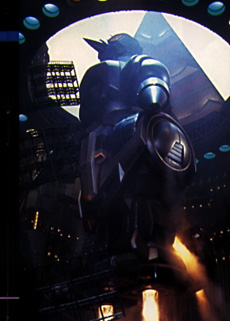
Aside from the dubbing, Columbia Tri-Star presents the films more or less intact (earlier
Godzilla films were frequently re-edited by their American distributors). The minor changes
made do not effect the body of the films: the Toho logo has been eliminated, and the end
credits have been truncated to include nothing but copyright notices. The loss of the end
credits for Destroyah is unfortunate: in the Japanese version they play over a
montage of clips from the original Godzilla and the Heisei films, set to a vigorous
rendition of Akira Ifukube�s Godzilla Overture that musically bookends the entire 41-year
series. The American version fades to black after three brief Godzilla clips, which
may leave viewers puzzling over why they're in the movie at all. The running times listed
on the packaging refer to the original Japanese versions. Because the lack of end credits,
the American versions are actually about two minutes shorter.
Although Toho produced deluxe laserdisc editions of the Heisei Godzilla films, no extras
of any kind are present on this disc. (The previous double feature included the Japanese
trailers for both of its films.) Each film has been allotted 28 chapter stops. The menus
are very basic, and easy to navigate.
Although the dubbed soundtrack and lack of extras is frustrating, Columbia Tri-Star's
Godzilla vs. Space Godzilla/Godzilla vs. Destroyah double feature does offer
American kaiju eiga fans good-looking and good-sounding versions of two Godzilla adventures
at a reasonable price, so most will want to add it to their collections. This summer,
Tri-Star will offer fans another treat when they release Toho's latest Godzilla film,
Godzilla 2000, in theaters across the country, returning the King of the Monsters
to the big screen at last. Let's just hope that when it comes time for the DVD (double
featured with Godzilla vs. Mecha-Godzilla, perhaps?) they can persuade Toho to let
them include Japanese dialogue tracks, and let fans hear the film as it is meant to be heard.
On a scale of Excellent, Good, Fair, and Poor,
Godzilla vs. Space Godzilla/Godzilla vs. Destroyah rates:
Movie: Poor (Godzilla vs. Space Godzilla);
Movie: Fair (Godzilla vs. Destroyah)
Video: Good
Sound: Good
Supplements: Poor
Packaging: Keep-Case
Reviewed: April 14, 2000
1 In his book Japan's Favorite Mon-Star
(1998, ECW Press), author Steve Ryfle explains that the
Heisei series is so called because it began during the first year of the Heisei Era, marked by
the reign of Emperor Akihito.
2 "Kaiju eiga" is Japanese for "monster movie."
3 Even though the creature is called Destroyah on the
packaging and the on-screen title, it
is called Destroyer in the dialogue and in the English subtitles. Why Toho and Tri-Star simply
didn't call the film Godzilla vs. Destroyer is anybody's guess.
4 Columbia Tri-Star's VHS cassette of 1994's
Godzilla vs. Mecha-Godzilla -- retitled
Godzilla vs. Mecha-Godzilla II to avoid confusion with the 1975 Godzilla film of the
same name -- reportedly features Surround Sound.
5 One example of deliberately changing the
dialogue occurs early in Destroyah. During
a conference on Godzilla, G-Force scientists conduct a teleconference with an American
colleague. In the Japanese version, they pick up telephone handsets to listen to a
translation of the scientist's English. Since everyone speaks English in the dubbed
version, the scientists are told that the call is on a secure line and that they must
pick up their "scramblers" to listen.
6 In Space Godzilla, carelessness
causes some incidental dialogue to be lost
altogether. In the Japanese version, p.a. announcements--in English--can be heard
directing the assembly of Mogera during the credit sequence. The announcements are
absent from the dubbed version.
Godzilla Text © Copyright 2000 Gary Teetzel
DVD Savant Text © Copyright 2007 Glenn Erickson
|













